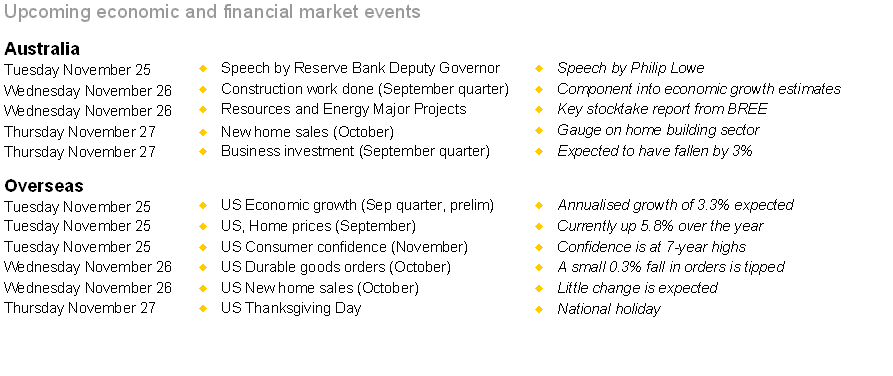The Week Ahead

Business investment figures dominate
The quarterly business investment figures will dominate the economic agenda this week. In the US, the economic calendar is well populated in the lead up to Thursday's Thanksgiving Day holiday. In China, no key economic data is expected.
The business investment figures go by the elongated title “Private New Capital Expenditure and Expected Expenditure” with the September quarter figures released on Thursday. And as the name implies, the data includes not just the latest estimates of business investment but also expectations of future investment, up to a year out, and at a sectoral level.
Interestingly, in this age of technology, the Australian Bureau of Statistics notes “The survey is conducted by mail on a quarterly basis. It is based on a random sample of approximately 8,000 units which is stratified by industry, state/territory and derived employment size. The figures obtained from the selected units are supplemented by data from units which have large capital expenditure and are outside the sample framework, or not adequately covered by it.”
Businesses also provide three figures each quarter -- a figure on actual investment for the quarter in question as well as a short-term investment expectation and a longer-term investment expectation.
Investment rose sharply from late 2006 to mid-2012, largely doubling in real terms, as Chinese demand for mining resources rose. But over the past two years, new business investment has eased from the highs, falling by 9 per cent. Further easing of investment is expected over the coming year but from lofty levels.
In fact, we expect that business spending fell by 3 per cent in the September quarter, the third decline in the past year. In terms of future investment, there has been surprising strength in the past six months with expectations lifting by 10.1 per cent in the March quarter and lifting 5.1 per cent in the June quarter. If expectations lift 2.5-3.5 per cent in the September quarter to around $148-150 billion, then this would be an encouraging result.
Other events to watch
On the drawing board in the coming week is a speech by Reserve Bank Deputy Governor on Tuesday -- the annual address to business economists. Investors will be looking for any remarks on the housing market, Australian dollar or even on the recently completed ChAFTA deal -- the free trade agreement between China and Australia.
The weekly ANZ-Roy Morgan survey of consumer sentiment is also issued on Tuesday.
On Wednesday, the ABS releases the “Construction Work Done” publication. The estimates of work done in residential building are most important as they act as inputs to the economic growth equation (September quarter GDP or economic growth data due on December 3). The estimates are also important as the Reserve Bank is monitoring the ‘baton pass' from mining investment to housing investment.
Also on Wednesday, the Bureau of Resources and Energy Economics releases the six-monthly stocktake report of key projects: “Resources and Energy Major Projects” -- a vital report for the building and construction industry sectors.
And on Thursday the housing Industry Association releases data on new home sales.
Overseas: US data dominates in holiday-shortened week
In the US, the week begins on Monday with the Dallas Federal Reserve index.
On Tuesday, a clutch of key indicators is released: economic growth, home prices, consumer confidence and influential regional surveys by the Federal Reserve in Dallas and Richmond.
The preliminary estimate of economic growth should show that US economy grew by 3.3 per cent in the September quarter. Consumer confidence probably held near 7-year highs in November while the FHFA and Case-Shiller home price measures probably showed annual growth of prices near 6 per cent.
On Wednesday, another significant clutch of economic data releases is expected. The data includes: personal income/spending, durable goods orders, new home sales, pending home sales, consumer sentiment and the Chicago purchasing managers' index.
A key measure of business spending -- durable goods orders -- is expected to have eased 0.3 per cent in October but a firmer 0.6 per cent increase is expected if volatile aircraft and defence orders are excluded.
And while little change is expected in measures on new home sales and pending home sales, the Chicago PMI may have eased from historical highs.
OPEC oil ministers meet to decide production quotas on Thursday.
The China-Australia Free Trade Agreement (ChAFTA)
There were the typical responses from the minority to the signing of ChAFTA. Interestingly, the responses occurred before examination of the final detail of the agreement and were along the lines of ‘what's in it for me'.
There will be winners and losers -- that is the nature of an agreement. But any efforts to reduce barriers preventing access to Australia's largest export destination and trading partner have to be positive. And it's not just any destination but the most populous nation on the planet and the biggest contributor to global economic growth.
While the reductions in tariff levels are useful in serving to lift Australian exports, probably the most important provisions in ChAFTA were those that will improve access to the Chinese services sector. As always though, it is up to Australian businesses to take advantage of the opportunities.
















